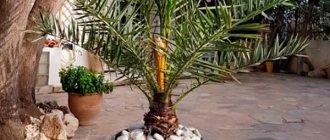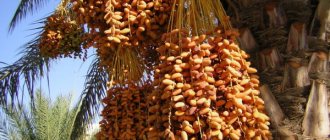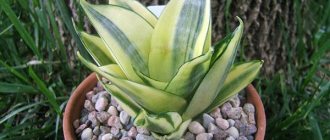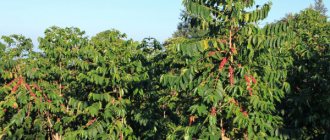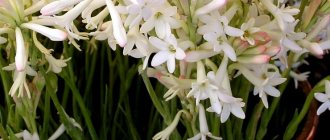Probably, everyone who simply adores dates for their unique taste would dream of growing a date from a seed at home. But will it be similar to the plant that grows in natural conditions? Growing a palm tree from a seed is not so difficult, and it does not require any special effort. But you are unlikely to ever see fruits on it, because such a plant does not bear fruit in indoor conditions. However, in order to grow such a palm tree, you need to know how to plant the seed correctly, and you also need to remember the basic rules of care.
Date palm from a seed: is it possible to grow it this way?
In general, if you plant a seed in a pot and provide it with proper care, you can get a palm tree. However, it is worth considering that such plants do not bear fruit at home, so you should not expect berries from them.
Date palm grows into a huge tree
How to germinate date pits at home: step-by-step instructions
So how to grow dates from seeds at home? There is no need to specifically look for date seeds. You can buy fruits at any vegetable store. Seeds must be germinated before planting, otherwise they most likely will not sprout or will sprout after a very long time.
Date seeds from which palm trees are grown
Properly germinate seeds as follows:
- The seeds are taken out of the dates.
- The seeds are carefully inspected, damaged ones or those with traces of possible diseases are discarded.
- The seeds are poured into containers with clean water and left for a day to remove any remaining pulp. The berries themselves contain specific substances that interfere with germination.
- After some time, the bones are thoroughly washed.
- The container is filled with loose soil (with vermiculite and hydrogel), a seed is placed, and covered with plastic film.
- It is better to place the pot near the radiator; germination will require a temperature of approximately 35 °C.
- The seeds germinate within a couple of months; during the entire period it is necessary to monitor the soil moisture and remove condensation from the film.
Note! After the first shoots appear, the plants are allowed to be planted in the selected soil.
Roots with pits
Types of dates that can be grown from seeds
Today, you can grow several varieties of dates at home:
- "Palmate". Suitable for large spaces, can reach 20 meters in height. It has a voluminous crown and a bare trunk.
- The Canary variety is slightly lower than its predecessor, growing up to 15 meters. Its fruits are small and dark orange in color.
- The Robelena date is the most popular palm tree. An adult plant reaches 2 meters in height.
- The Ceylon date is distinguished by shortened leaves.
- The curved date has several trunks, which is why it resembles a bush rather than a tree.
Preparing date pits for planting
Growing a palm tree is a rather long process. Normal leaves of the crop will appear only in the third year; flowering at home occurs quite rarely. Over time, the palm tree can grow up to two meters.
Date palm - how to grow at home
Before growing a date from a seed, it is worth carrying out several operations to avoid disappointment later.
Selection and preparation of planting material
The correct selection of planting material plays an important role. Not all dates are able to germinate. For further planting, you need to choose fresh or dried berries that have not undergone heat treatment.
For your information! The fruits contain fairly large seeds that retain the ability to germinate for several years.
To speed up seed germination, you can subject it to mechanical processing:
- prick the surface with a needle;
- lightly sand with sandpaper;
- cut with a blade;
- pour over boiling water.
Germination process
Then the seeds are placed in moistened cotton wool, which is placed in a glass and covered. Leave the container in a warm room and make sure that the cotton wool does not dry out. After the sprout appears, it can be rooted and transplanted to a permanent place.
Soil selection
Soil for palm trees is selected with a large amount of nutrients. The soil must have good air and water permeability. It is acceptable to purchase ready-made soil for palm trees in a store. A universal primer will also work. If you wish, you can prepare the mixture yourself. For this purpose, sand, turf soil, compost or humus are mixed in equal parts.
Important! It is recommended to add superphosphate in the amount of 1 tbsp to the finished soil. spoons per 3 liters of soil.
You can prepare the soil with a slightly different composition: 2 parts of turf are mixed with 1 part of sand and 1 part of peat. Then a small amount of coal is added to the mixture.
The first shoots will appear in a few days
Purchased or prepared soil must be disinfected using any of the methods described below:
- roasting in the oven;
- treatment with boiling water;
- treatment with a weak solution of potassium permanganate;
- calcination in a microwave oven.
After all treatments, the seeds can be planted.
Date pests and diseases
How to grow a date healthy and protect it from pest attacks? If you have provided your pet with the best care and the most comfortable conditions, then your palm undoubtedly has strong immunity. This means that common diseases such as spotting or pink rot will not affect your pet. If this problem does appear, use fungicides. "Mancozeb" and "Ridomil" will cope with this task perfectly. Insecticides will help those who enjoy eating exotic palm trees. The most important thing is to notice the moment of their appearance in time, then they will cause minimal damage.
Planting a sprouted seedling
A sprouted seed is not difficult to plant and grow. It is placed vertically in the hole, then gradually covered with earth. Water with a small amount of water and move the pot to a warm place. No special conditions are required for planting; you can choose any container for germination.
Liviston palm - how to plant and care at home
It is recommended to replant the sprouts together with the soil in which they were germinated. For each seedling, you need to prepare a suitable deep pot and soil. Expanded clay and charcoal are poured onto the bottom of the container; the drainage layer should be at least 2 cm.
Note! The next transplant is carried out when the length of the first leaf reaches 15 cm.
How to germinate a seed
The seed for germination can be taken from fresh, sun-dried or dried dates that have not been subjected to heat treatment. The fresher the product you use, the greater your chances of success.
Dried dates
Preparing the seed for planting
Before planting, the pit removed from the date must be thoroughly cleaned of pulp, washed and dried. Otherwise, the remaining organic matter in the soil may rot. It is then processed to speed up germination.
To do this, damage the hard shell, choosing one of the following methods:
- They scratch it with a sharp knife;
- Make cuts with a file;
- Wipe with sandpaper.
As a result, it will be easier for water to penetrate through the shell to the core and activate germination.
Then the bone needs to be soaked in warm water, or placed between layers of damp gauze. To prevent moisture from evaporating, cover the container with a lid and place it in a warm place. And to prevent microorganisms from developing in it, the water is periodically changed and the gauze is rinsed.
The seeds swelled and began to sprout
Advice. Soak several seeds at once, even if you only need one plant. Some of them may not sprout, some may die during transplantation, and from the remaining shoots it will be possible to select the strongest ones.
Such preliminary preparation will reduce the germination time by several months. If you simply plant a seed in the ground and water it, it can germinate in six months or even later. Or not germinate at all.
And after soaking, sprouts appear within 2-3 months. You can plant dates at any time of the year, but the best time is the end of winter - the beginning of spring.
Landing
If you have the patience, you can wait for the seeds to germinate in the water, making sure that it does not stagnate or evaporate. In this case, only sprouted seeds can be planted in the ground.
Sprouted date seeds
But a few days are enough for them to swell and increase in size. Caring for seeds in the ground is less tedious.
- Prepare a mixture of equal parts of universal commercial soil and sand;
Components of soil mixture for germination
- Place expanded clay drainage at the bottom of the container and fill it with soil mixture;
- Using a stick, make a deep hole in the compacted soil and place the seed vertically in it. There should be 1-1.5 cm of soil above it;
Hole for planting
Moment of landing
Try not to damage the sprout if there is one.
- Water the plantings with warm water, cover the container with a transparent lid or film and place in a bright and warm place.
Advice. Young plants do not tolerate transplantation well, so if possible it is better to plant each seed in a separate cup.
To germinate, dates need a temperature of about 25 degrees. Until shoots appear, the soil should be kept moist and the plantings should be ventilated frequently.
Sprouts may appear in two weeks or 3-4 months after planting, so be patient and do not stop watering your “plantation.” Young shoots resemble light green sticks pointed upward. This is the first leaf that will stretch out and open within a few days.
Emergence of seedlings
3-4 days
Two weeks
Dates planted at the same time may germinate far behind each other.
How to care for date palm seedlings at home
Palma Howea - home care
It is not enough just to plant a seed; proper care of a date palm from a seed at home is important. It is imperative to follow all the rules and conditions so that the small sprout does not die.
Young plants require special care
Location and lighting
The date palm can grow up to 2 m in height, so it is recommended to choose a bright and spacious room for it. An adult flower requires a lot of space; the amount of furniture needs to be reduced. However, the palm tree grows quite slowly; it will reach its full size after 10 years.
In nature, palm trees grow in the sun, but houseplants cannot tolerate direct sunlight. Therefore, it is better to place the pot in a bright place near southern, western or eastern windows.
Important! In particularly hot weather, the leaves are shaded from the bright sun.
It is recommended to constantly rotate the palm tree so that all leaves receive an even amount of light. Otherwise, leaves will grow well on only one side.
If in the fall there was not enough light for such a plant, then in the spring they gradually begin to accustom it to the sun. With a lack of light, the leaves wither or stretch out.
The normal temperature for a palm tree is 25 °C. In summer it can tolerate heat of 30 °C. However, in such a case, be sure to maintain suitable humidity. The plant is constantly sprayed.
The winter period is accompanied by plant dormancy. The optimal temperature is approximately 18 °C, but not lower than 14 °C. Sudden changes have a bad effect on the condition of the palm tree.
Note! In spring you can transfer the flower to the balcony. At first, an hour will be enough, gradually increasing the time spent in the fresh air. At night the flower is brought indoors. However, it is not recommended to constantly move the pot; this may have a bad effect on the condition of the palm tree.
Air humidity
The most suitable air humidity should not exceed 70%. In winter, it is not recommended to leave a palm tree near a heating radiator. The leaves are regularly wiped with a damp cloth.
Important! In the summer heat, the plant is sprayed once a week.
It is equally important to follow the rules of watering the flower. In nature, the plant has quite long roots, so it can tolerate heat and drought. However, at home, the palm tree is provided with the necessary amount of moisture. The following rules should be followed:
- It is recommended to drain excess water from the pan. For irrigation use soft, non-chlorinated water;
- in the warm season, the flower can be sprayed often, the palm tree likes it, but moisture should not get into the rosette;
- after planting the seeds, monitor the condition of the soil; it should not be over-moistened; the soil should be almost dry;
- from April to August the amount of watering is increased, in cold weather it is reduced.
It is important not to overwater the plant to avoid the development of fungal diseases.
A young palm tree does not require frequent watering
Soil and pot requirements
There is no need to take a large pot for a palm tree. When transplanting, the container should be 2-3 cm in diameter larger than the previous one. However, a tall pot is required because the plant has long roots.
The soil for a palm tree should be loose and nutritious, which allows water and air to pass through well. If necessary, the plant is fed with special fertilizers intended for palm trees.
Note! It is also possible to use preparations for ornamental deciduous plants with a high nitrogen content. This element promotes the formation of green mass. It is recommended to give preference to drugs in liquid form, as they are easier to use.
Priming
Soil for planting dates can be purchased at the store, but it will be better if you make it yourself, because it is not at all difficult.
To sow seeds you will need soil with the following composition :
- 1 part steamed peat soil;
- 1 part sand or perlite;
- 1 part raw sawdust.
The main requirement for soil is that it is light, loose, and has good permeability to air and moisture.
The composition of the soil will have to be changed several times depending on the age of the flower.
Timing and technology of transplantation
If the plant is less than 5 years old, then replanting is carried out every year, then as needed, because such a procedure is difficult for an adult plant to tolerate. An indicator that the flower needs to be replanted are roots protruding from the drainage holes. This indicates that the pot has become small.
Important! The soil is selected the same as for planting.
Transshipment is considered the best method of replanting, because the palm tree has very delicate roots that can easily be damaged. A drainage layer is poured onto the bottom of the new pot, after which the palm tree is placed in it along with a lump of earth. Add new soil and water the plant.
Planting in a large pot can cause the flower to stop growing.
Every six months it is recommended to update the topsoil to saturate the soil with new nutrients.
An adult plant after 5 years is not replanted every year, but only the top layer of soil is renewed
Palm diseases
Unbalanced care can lead to plant diseases. It is important to help in time to prevent the palm tree from deteriorating and dying.
The tips of the leaves dry out
If the plant is not moistened by spraying and removing dust with a damp cloth, the tips of the leaves begin to dry out. It also dries out if there is insufficient watering. Take care to moisten the soil and air.
This problem can also occur as a result of a lack of minerals, as well as exposure to drafts.
Drying of the tips can also be the result of the plant being shaded: make sure that the date palm is not in the dense shade of another plant or some object for a significant part of the day.
The leaves are turning yellow
The cause of yellowing is increased dryness. A change in color indicates that the palm tree is not sprayed (which means the required level of humidity is not provided) and is not watered regularly (the earthball dries out).
Another possible reason for leaves drying out and changing their color is frequent replanting. Delicate roots do not have time to adapt to new conditions - and the Phoenix can shed its foliage.
The foliage is darkening
Palm leaves darken from waterlogging, and at the same time the trunk may soften. You must immediately check the roots of the plant by carefully removing it from the pot or tub.
If the roots also become dark and softened, then the plant can no longer be saved.
If there are living roots left, then you need to try to save them. To do this, you need to remove dead roots, sprinkle the cuts with coal, transplant the palm tree into fresh soil and strictly adhere to the watering regime.
Stopping growth
There are two main reasons for growth failure:
- Excessive soil acidity: if the acidity level exceeds 7 pH, then there is a lack of microelements that ensure the growth and development of the palm tree.
- Hypothermia: if the temperature drops below 17 degrees, the root system of the palm tree practically stops development. Therefore, it is advisable that the temperature in the room does not fall below 20 degrees.
Possible problems arising when growing from seed
If the rules of plant care are not followed, various problems may arise in growing:
- dry ends occur due to lack of moisture, it is worth spraying the flower more often;
- the leaves turn yellow due to dry soil, you need to monitor watering;
- darkening of the leaves is the result of excess moisture;
- the palm tree does not grow. Most likely she’s just cold, it’s worth checking the air temperature in the room;
- yellow or brown spots appear on the leaves - a sign of potassium deficiency;
- the presence of bright yellow spots along the edges indicates a lack of magnesium;
- light leaves, lack of growth - not enough nitrogen, it’s worth feeding the flower;
- the appearance of leaf chlorosis indicates a lack of manganese. Fertilizers will help.
What can destroy a palm tree seedling?
The date palm is an unpretentious plant, however, it is also susceptible to various diseases and can be affected by harmful insects. The danger for palm trees is:
- spider mite Appears when the ambient temperature changes frequently. The first symptom is a lot of yellow and brown spots;
- scale insect. The leaves turn yellow and brown plaques appear on them;
- thrips. A whitish tint appears on the top of the sheets, brown on the bottom;
- worm. When damaged, the plant quickly withers and dries out.
You can cope with insects using special preparations. It is also acceptable to use homemade products.
Palm tree is a wonderful ornamental plant. If desired, it is possible to grow a date tree at home even from a seed, the main thing is to strictly follow all the rules of germination and planting. Only then, after a few years, can you get a beautiful large plant that will delight you with abundant green foliage. The only negative is that you won’t be able to get the fruits at home.
Hot chocolate capsules Nescafe Dolce Gusto Chococino, 8 servings
334 ₽ More details
Nesquik Opti-Start instant cocoa drink, 250 g (package)
125 ₽ More details
Seeds
Description, beneficial properties of jujube
Jujube is a member of the buckthorn family. It is the most important fruit crop growing in dry tropical or hot subtropical deserts, as well as semi-deserts.
The fruits of the date palm are round and fleshy. They are covered with a smooth brownish peel, which acquires a reddish tint as it ripens. The pulp has a sweet taste and juiciness.
The caloric value for 100 g of jujube fruit is 79 kcal. They are rich in ascorbic acid, retinol, B vitamins (adermine, niacin, riboflavin). The fruits of the date palm also contain a large amount of useful minerals: potassium, copper, manganese, iron, calcium.
The rich composition determines the beneficial properties of dates. They have sedative, hypotensive, diuretic properties. Eating jujube fruits helps:
- strengthening the immune system;
- improving vision;
- normalization of the nervous system;
- removing toxins, heavy metals and excess fluid from the body;
- improvement of digestive processes;
- stimulation of bile secretion.

